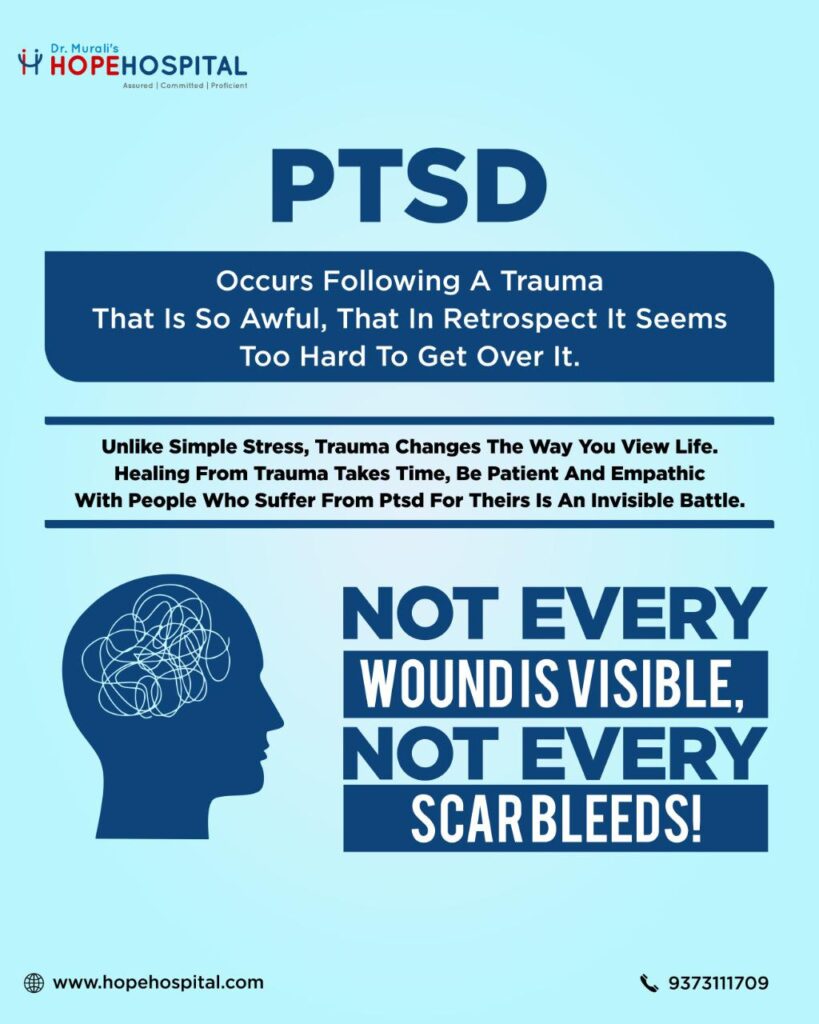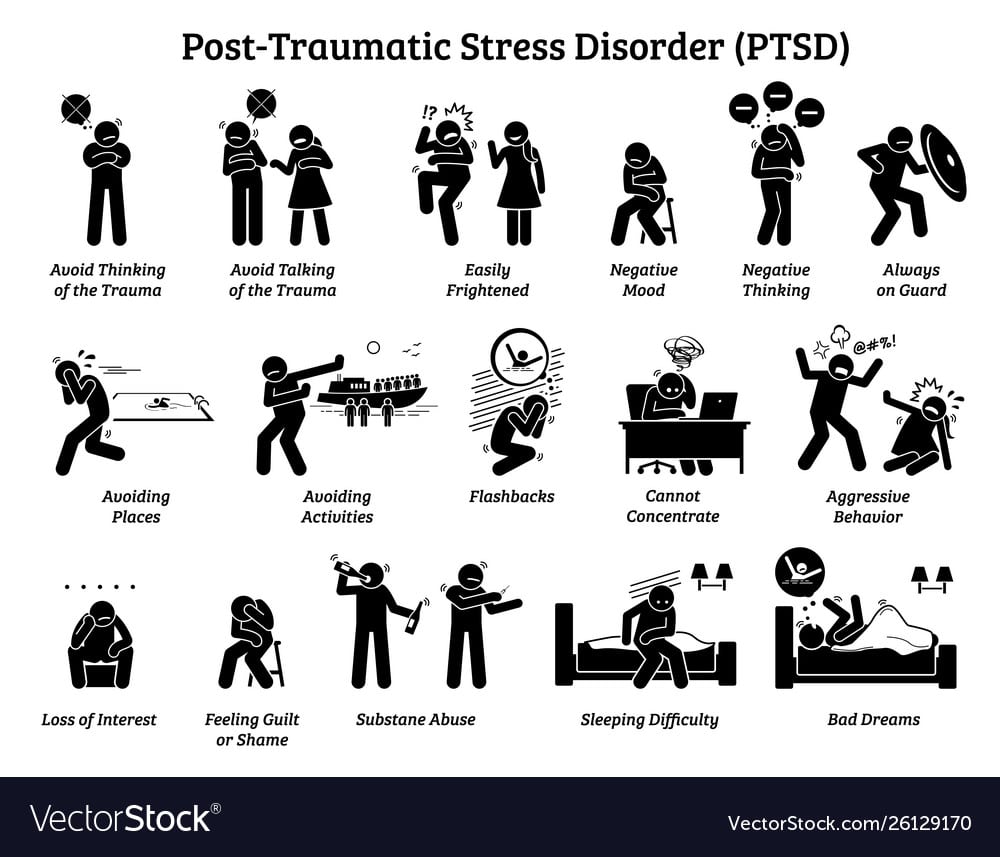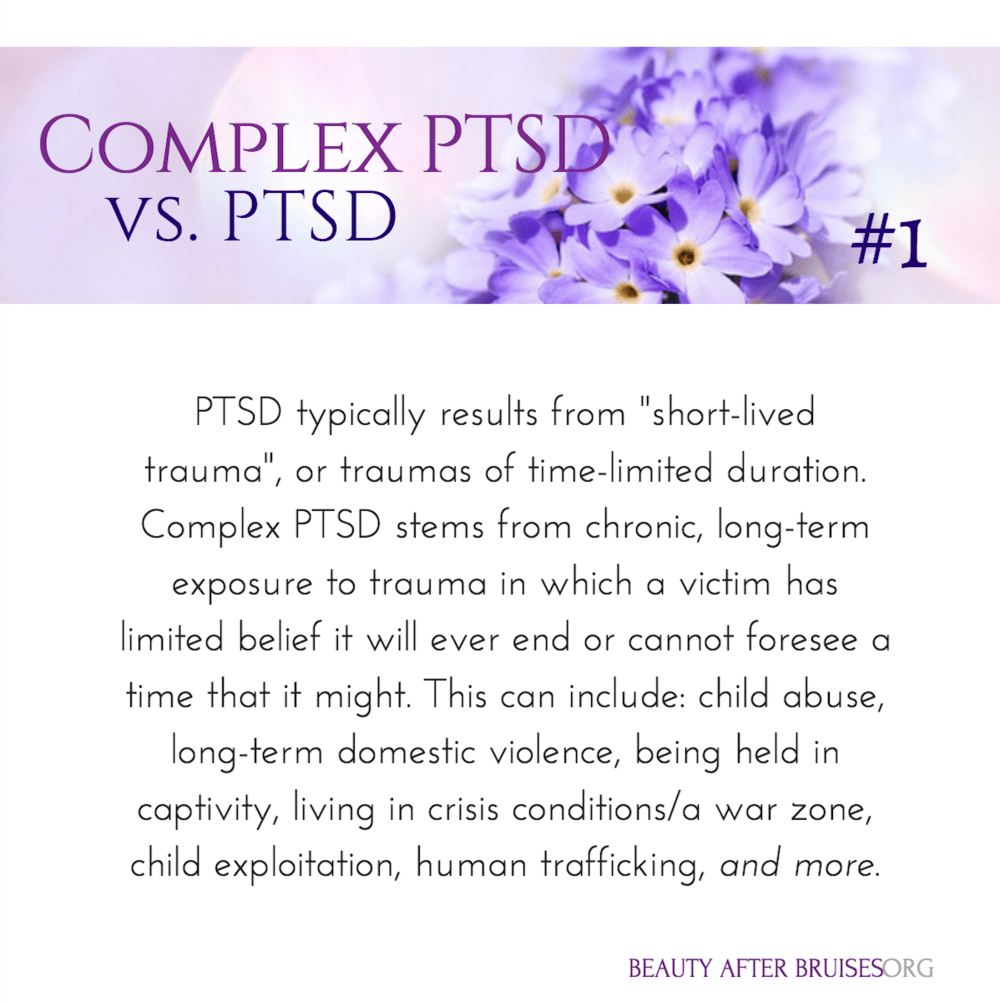How Does Ptsd Happen
During a trauma, your body responds to a threat by going into âflight or fightâ mode. It releases stress hormones, like adrenaline and norepinephrine, to give you a burst of energy. Your heart beats faster. Your brain also puts some of its normal tasks, such as filing short-term memories, on pause.
PTSD causes your brain to get stuck in danger mode. Even after youâre no longer in danger, it stays on high alert. Your body continues to send out stress signals, which lead to PTSD symptoms. Studies show that the part of the brain that handles fear and emotion is more active in people with PTSD.
Over time, PTSD changes your brain. The area that controls your memory becomes smaller. Thatâs one reason experts recommend that you seek treatment early.
What Are The Symptoms Of Ptsd In Children
Children may have symptoms like those above or other symptoms. As children get older, their symptoms are more like those of adults. Here are some examples of PTSD symptoms in children and teens:
- Children under 6 may get upset if their parents are not close by, have trouble sleeping, or act out the trauma in their play.
- Children ages 7 to 11 may also act out the trauma through play, drawings, or stories. Some have nightmares or become more irritable or aggressive. They may also want to avoid school or have trouble with schoolwork or friends.
- Children age 12 to 18 have symptoms more similar to adults: depression, anxiety, withdrawal, or reckless behavior like substance abuse or running away.
Read more about PTSD in Children and Teens.
Emotional And Psychological Trauma
If you’ve experienced an extremely stressful eventor series of eventsthat’s left you feeling helpless and emotionally out of control, you may have been traumatized. Psychological trauma often has its roots in childhood, but any event that shatters your sense of safety can leave you feeling traumatized, whether it’s an accident, injury, the sudden death of a loved one, bullying, domestic abuse, or a deeply humiliating experience. Whether the trauma happened years ago or yesterday, you can get over the pain, feel safe again, and move on with your life.
Also Check: National Veterans Legal Services Program
How Do Children And Teens React To Trauma
Children and teens can have extreme reactions to trauma, but their symptoms may not be the same as those seen in adults. In young children under the age of 6, symptoms can include:
- Wetting the bed after having learned to use the toilet
- Forgetting how or being unable to talk
- Acting out the scary event during playtime
- Being unusually clingy with a parent or other adult
Older children and teens usually show symptoms more like those seen in adults. They also may develop disruptive, disrespectful, or destructive behaviors. Older children and teens may feel guilty for not preventing injury or deaths. They also may have thoughts of revenge.
For more information, see the National Institute of Mental Health brochure, Helping Children and Adolescents Cope With Disasters and Other Traumatic Events.
Risk Factors For Ptsd

The National Center for PTSD reports that more than 7% of Americans will likely develop PTSD at some point in life. Women are more likely than men to develop it, and genetic factors may also make some people more likely to develop it than others.
Its true that most people who experience a traumatic event will not develop PTSD. However, some risk factors that might make you more likely to experience this mental health condition can include:
- Exposure to multiple dangerous or traumatic events
- Physical, emotional, or sexual abuse
- Neglect during childhood
- History of alcohol or substance abuse
- Witnessing a dead or mutilated body
- History of mental health conditions
- Lacking social support
- Genetic predisposition
Some research shows youre more likely to develop PTSD if you have to deal with extra stress after a traumatic event, such as enduring pain or injury, loss of a job, or the death of a loved one.
While there are important risk factors that contribute to the development of PTSD, its also important to know that getting support and reaching out to communities that can help will make a difference. For example, a veteran who attends a group with other veterans can connect with others who have experienced similar situations and decrease their isolation while connecting with other people experiencing similar symptoms there can be significant healing within a shared community.
Recommended Reading: How Much Does Mental Health Disability Pay
Does Trauma Always Cause Ptsd
No. Going through trauma does not always cause PTSD. Most kids and teens who go through a trauma will not get PTSD.
But most of them will feel the effects of trauma. Its normal to react to a deeply stressful event. Most will have upset feelings, thoughts of the trauma, and other signs of distress. This may last for a short while, sometimes days or weeks. With comfort, listening, and support, most can find ways to cope with what theyve been through.
PTSD develops when a trauma overwhelms a childs ability to cope. Kids and teens with PTSD need extra help to move through the coping process.
Things that affect whether someone develops PTSD after a trauma include:
- how severe the trauma was
- how quickly they get help and support
- a past history of trauma
- inherited risks like family history of depression and anxiety
Finding A Therapist For Ptsd
When looking for a therapist, seek out mental health professionals who specialize in the treatment of trauma and PTSD. You can ask your doctor or other trauma survivors for a referral, call a local mental health clinic, psychiatric hospital, or counseling center.
Beyond credentials and experience, it’s important to find a PTSD therapist who makes you feel comfortable and safe. Trust your gut if a therapist doesn’t feel right, look for someone else. For therapy to work, you need to feel comfortable and understood.
Don’t Miss: Does Anxiety Count As A Disability
How Common Is Ptsd
Here are some facts :
- About 7 or 8 out of every 100 people will have PTSD at some point in their lives.
- About 8 million adults have PTSD during a given year. This is only a small portion of those who have gone through a trauma.
- About 10 of every 100 women develop PTSD sometime in their lives compared with about 4 of every 100 men . Learn more about women, trauma and PTSD.
Personal factors, like previous traumatic exposure, age, and gender, can affect whether or not a person will develop PTSD. What happens after the traumatic event is also important. Stress can make PTSD more likely, while social support can make it less likely.
Learn more: How Common is PTSD?
Ptsd And Dissociative Disorders
Dissociation is a common result of trauma.
According to the American Psychiatric Association, about 90% of people with dissociative disorders have experienced childhood abuse and neglect.
Dissociation is a disconnect between your thoughts, memories, emotions, and sense of self. It can happen during a traumatic event as your bodys way of distancing yourself from a very difficult situation. Dissociation can also arise long after the traumatic event has ended.
Each persons experience of dissociation may be slightly different. Two major types of dissociation are:
- Depersonalization: where you feel disconnected from your body. Some describe it as an out-of-body experience.
- Derealization: where people or objects around you appear unreal. The world may appear unnatural.
There are three types of dissociative disorder:
Recommended Reading: How Do You Apply For Social Security Disability
Support Is Important For Recovery
Many people experience some of the symptoms of PTSD in the first two weeks after a traumatic event, but most recover with the help of family and friends. For this reason, for a diagnosis of PTSD is not made until a month after the event. Treatment does not usually start for at least two or more weeks after a traumatic experience. However if the event is very distressing and emotions and reactions are intense, it is advisable to seek help as early as possible to understand what is happening and help recovery to start.
It is important during the first few days and weeks after a traumatic event to get whatever help is needed. This may include accessing information, people and resources that can help you to recover. Support from family and friends may be all that is needed. Otherwise, a doctor is the best place to start to get further help.
What Kind Of Trauma Leads To Ptsd
1. Exposure to:
2. Exposure can be:
Also Check: Is Post Traumatic Stress Disorder A Disability
How Do Traumatic Events Lead To Ptsd
Its really difficult to isolate exactly how any given incident might cause PTSD. Processing a traumatic event is incredibly different for everyone, so a variety of factors come into play when trying to establish exactly how, or if, a trauma will lead to the development of PTSD symptoms.
Being able to process a traumatic event is different for each individual, and a variety of factors contribute to the development of PTSD symptoms. Its crucial to remember that, when were overwhelmed by trauma, the impact can be experienced by people in a wide variety of ways, both physically and mentally, that can develop into PTSD either in the short term or later on.
Arousal And Reactivity Symptoms Include:

- Being easily startled
- Feeling tense or on edge
- Having difficulty sleeping
- Having angry outbursts
Arousal symptoms are usually constant, instead of being triggered by things that remind one of the traumatic events. These symptoms can make the person feel stressed and angry. They may make it hard to do daily tasks, such as sleeping, eating, or concentrating.
Read Also: Why My Account Is Disabled
What Does Ptsd Feel Like And Who Can Experience It
We often think of PTSD as a risk for soldiers, for people fighting in war, or those doing military service. Although it is a risk for them, PTSD can develop from any event that feels overwhelmingly threatening or scary to the person involved. It can happen to anyone, at any age, at home or anywhere.
Domestic violence, rape, child abuse and neglect, terrorist attacks, natural disasters, car accidents these are just a few of the traumas that can lead to PTSD. It can also come from events that appear far less dramatic such as ongoing bullying, a playground accident, or a medical procedure during childhood. It is important to recognize the myth that only obviously life-threatening events carry the risk of PTSD. Rather, PTSD is the result of the reactions and/or perceptions of the person traumatized.
The difference between PTSD and other types of traumatic experiences is that unwanted symptoms stay they keep returning and intruding on the persons present awareness.
How Can Ptsd Affect Your Life
Post-traumatic stress disorder is a mental health condition caused by a traumatic event or a high-stress period in a persons life. There are several types of PTSD triggers, including:
- Witnessing death
PTSD is characterized by a heightened sense of danger and stress, even when youre going about the normal activities of your day.
You may also experience flashbacks, panic attacks, nightmares, and general anxiety. Not everyone who experiences a traumatic event develops PTSD. However, around 7% to 8% of people will experience PTSD at some point in their lives. PTSD is more likely to occur in people who experience assault and sexual assault. Women are more likely to experience PTSD than men, with 10% of women and 4% of men dealing with the disorder.
PTSD can interfere with many aspects of your life, including your job, relationships, health, and quality of life. One of the common symptoms of PTSD is avoidance, which is an aversion to places or activities that remind you of a traumatic event in your past.
People who experience avoidance may not want to return to locations or participate in activities because they fear it will trigger fear, anxiety, or panic. Avoidance is also a symptom of panic disorders. Panic attacks can occur in someone who has PTSD, increasing the risk of experiencing avoidance.
Also Check: Where Do You Send Disability Forms
Signs And Symptoms Of Ptsd
PTSD develops differently from person to person because everyone’s nervous system and tolerance for stress is a little different. While you’re most likely to develop symptoms of PTSD in the hours or days following a traumatic event, it can sometimes take weeks, months, or even years before they appear. Sometimes symptoms appear seemingly out of the blue. At other times, they are triggered by something that reminds you of the original traumatic event, such as a noise, an image, certain words, or a smell.
While everyone experiences PTSD differently, there are four main types of symptoms.
When To Seek Help For Ptsd
A person who has experienced a traumatic event should seek professional help if they:
- donât feel any better after two weeks
- feel highly anxious or distressed
- have reactions to the traumatic event that are interfering with home, work and/or relationships
- are thinking of harming themselves or someone else.
Some of the signs that a problem may be developing are:
- being constantly on edge or irritable
- having difficulty performing tasks at home or at work
- being unable to respond emotionally to others
- being unusually busy to avoid issues
- taking risks or not caring what happens to oneself
- using alcohol, drugs or gambling to cope
- having severe sleeping difficulties.
Also Check: How To File Va Disability Claim
How Can I Help A Friend Or Relative Who Has Ptsd
If you know someone who may be experiencing PTSD, the most important thing you can do is to help that person get the right diagnosis and treatment. Some people may need help making an appointment with their health care provider others may benefit from having someone accompany them to their health care visits.
If a close friend or relative is diagnosed with PTSD, you can encourage them to follow their treatment plan. If their symptoms do not get better after 6 to 8 weeks, you can encourage them to talk to their health care provider. You also can:
- Offer emotional support, understanding, patience, and encouragement.
- Learn about PTSD so you can understand what your friend is experiencing.
- Listen carefully. Pay attention to the persons feelings and the situations that may trigger PTSD symptoms.
Therapy Can Influence How Long Ptsd Lasts
Research has proven therapy to be helpful in reducing and overcoming PTSD . Therapy reduces the duration of PTSD because as the therapist and client work together,
- Traumas negative impact is decreased and the person can return to his/her earlier level of functioning
- The person learns effective, healthy coping skills so PTSD doesnt last as long
- Memories, negative thoughts and intense feelings become easier to deal with
- Healthy new behaviors are learned to replace PTSD-induced avoidance, anger, etc.
Generally, therapy lasts between six and 12 weeks. It may last longer than that, but even so, it still diminishes how long PTSD lasts .
Recommended Reading: Can You Be On Disability And Collect Social Security
Impact Of Ptsd On Relationships And Day
PTSD can affect a personâs ability to work, perform day-to-day activities or relate to their family and friends. A person with PTSD can often seem uninterested or distant as they try not to think or feel in order to block out painful memories. They may stop them from participating in family life or ignore offers of help. This can lead to loved ones feeling shut out.
It is important to remember that these behaviours are part of the problem. People with PTSD need the support of family and friends but may not understand what is happening to them or think that they need help.
When PTSD goes on for some time, it is not unusual for people to experience other mental health problems at the same time. In fact, up to 80 per cent of people who have long-standing PTSD develop additional problems – most commonly depression, anxiety, and alcohol or other substance misuse. These may have developed directly in response to the traumatic event or as a result of the effects of having PTSD.
Eye Movement Desensitization And Reprocessing

EMDR is a trauma-focused psychotherapy approach. It involves recalling a traumatic memory, including the thoughts, feelings, and body sensations that come up while doing so.
In some ways, it is similar to exposure treatment. What makes it different is that while recalling the traumatic memory, people are asked to focus their attention on an external stimulus that invokes side-to-side movements of the eyes. It is thought that the side-to-side eye movements help to facilitate the processing of the belief by activating both brain hemispheres.
The National Center for PTSD provides more in-depth information on trauma-focused treatments.
You May Like: Washington State Short-term Disability 2021
